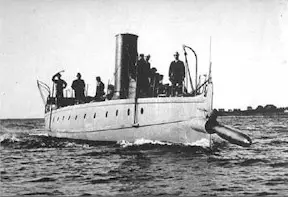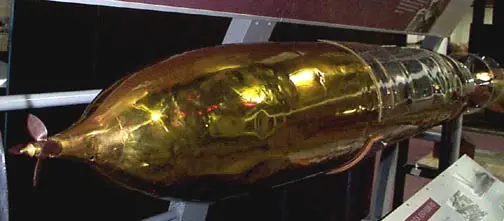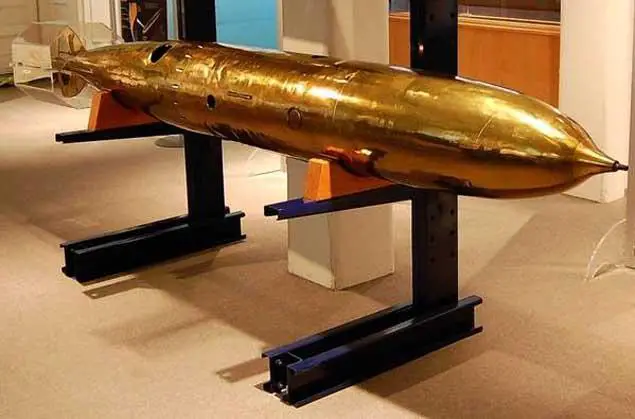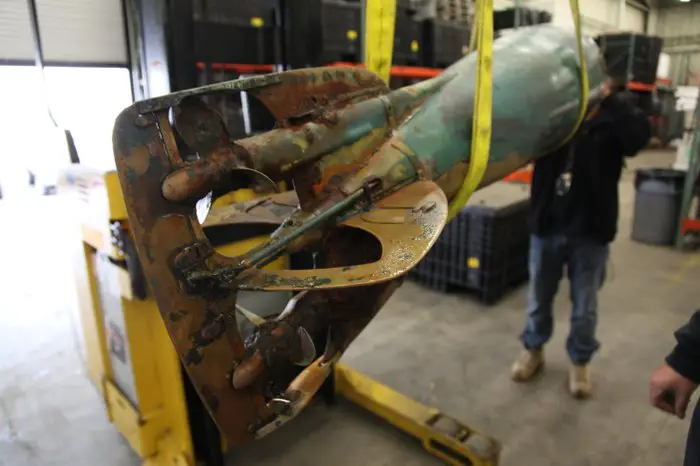The grinning grey guy in the photo is one of the Navy’s marine mammals, from the Space and Naval systems Center, Pacific, and the hero of this piece. This marine mammal or one of its cohorts at the center turned a mine-hunting exercise into an archaeological expedition this March.
Deep in the cold Pacific, the dolphin found a manmade object. Unlike recent marine weapons, like the dummy mines the critter was seeking, the 11-foot long torpedo was made of brass and had a certain steampunk sensibility. It was quickly identified as a Howell torpedo, one of fifty experimental torps made, and expended, before Robert Whitehead made the weapon truly practical. The Howell was one of the first self-propelled torpedoes, or as the terminology of the gaslight age called them, “automobile torpedoes,” of the 19th Century. It and its followers would revolutionize Naval warfare in the next century, making it possible for an invisible threat to blockade a warring nation. (Submarine warfare fell short of cutting off England, twice, but it crippled the defense industries and economy of Japan, and starved out more Japanese garrisons than ever ended on the point of Marine bayonets). But most of the 50 Howells have slept with the fishes for over a century. Including one that interposed itself into a marine mammal minehunting exercise in March.
A Navy dolphin training to look for mines off the coast of San Diego found a museum-worthy 19th-century torpedo on the seafloor, military officials said.
The brass-coated, retro wonder of technology was one of the first self-propelled torpedoes used by the U.S. Navy. Just 50 of these so-called Howell torpedoes were made and only one other example has been recovered; it sits in the Naval Undersea Museum in Keyport, Wash., outside of Seattle.
Here’s the picture of the lovingly over-restored example from the Undersea Museum. Beautiful, isn’t it? (The museum site says it has the only Howell in existence, but it wasn’t correct even before the dolphins’ find off Coronado this spring. We think this is the only post that will show you three extant examples of the Howell, and we hesitate to say all three because the USN might have another one ratholed in some museum… or a warehouse where some Chief parked it in 1890 rather than be caught short). Here’s the real Undersea Museum example:
The news stories all have the count wrong, but there’s apparently a third example at the Navy War College museum. Some of the stories misidentify this photo as the Undersea Museum example, but WeaponsMan has it right. We think, we link, you decide:
via Navy dolphin finds 130-year-old torpedo | Fox News.
In shape, it resembles a modern torpedo, although with more learned about hydrodynamics in the last 130 years, the pointy nose isn’t used any more (it’s counterintuitive, but has more drag than a blunt one). The Howell pointed the way to the future but its numbers were pretty limited: range of less than 1/4 mile (although some sites say 700 yards), speed a mere 25 knots, and warhead 100 lbs of guncotton. The propeller on the nose (visible only on the Undersea Museum’s Howell) was a safety device that armed the fuze. The Howell seems archaic today, and it is. But in 1870 it was a harbinger of what was to come. This photo of the recovered torp shows its propulsion end:
See what we mean about steampunk sensibility? Shortly after this photo was taken, the torp was reimmersed in water to prevent corrosion, at least until it can be properly treated by preservation specialists. Its bronze structure is in surprisingly good shape for over a century in salt water, but that’s bronze for you. Durable stuff. Torpedoes today have amazing capabilities in terms of speed, stealth, autonomy, and/or operator guidance from the launch ship/sub/aircraft (two of which platforms did not exist when this torpedo was invented), but they all descend from primitive 19th Century torpedos like this one.
 The limited range and speed stemmed from the Howell’s mechanism: it had no on-board motor per se, simply a flywheel that was spun up to 10,000 RPM by shipboard equipment. The flywheel (F in the blueprint at this article’s end) weighed 132 lbs. — more than the torp’s warhead. It was, practically, a clockwork torpedo.
The limited range and speed stemmed from the Howell’s mechanism: it had no on-board motor per se, simply a flywheel that was spun up to 10,000 RPM by shipboard equipment. The flywheel (F in the blueprint at this article’s end) weighed 132 lbs. — more than the torp’s warhead. It was, practically, a clockwork torpedo.
One vessel that carried the torpedoes was the torpedo boat Stiletto, here discharging a Howell circa 1890 (sorry, this image is only available in this little size). Remember: archaic now, but it was the high-tech of its day.
There were many competitive designs flowering at the same time. The Whitehead (1868, Austria) was powered by compressed air. The Fish (1871, USA) was armed with 100 pounds of explosive (dynamite) and powered by compressed air, but was the first driven by screws. (The sole survivor Fish is in the Navy War College museum in Newport, RI, which also hosts a surviving Howell). The Howell was made from 1870 or 1871 to 1889 in Rhode Island, and was designed by a Naval officer, Lt. Cmdr. John A. Howell.
Before this flowing of invention “torpedoes” were what we’d now call surface mines, floating explosive charges. (that’s what the torpedoes that Farragut famously damned were). After the US Civil War, the 19th Century’s flowering of metallurgy, power, and power transmission made the set-it-and-forget-it torpedo a real possibility, and inventors worldwide flocked to it. The US finally replaced the Howell with an improved Whitehead design. (Whitehead was American, but first succeeded in the Hapsburg Empire, in part because he’d married into the nobility there).
More news stories at the New York Daily News (describing how one dolphin found the target, another confirmed it, and human EOD techs classified it as the Howell), and the Los Angeles Times (with great background on the find and the Navy marine mammal program, which trains dozens of bottlenose dolphins and sea lions). .
The Howell torpedo has been recovered and is undergoing preservation. The dolphins have a more uncertain future: the Navy program is threatened by budget cuts and the advancing capabilities of underwater remote operated vehicles.
Update
The Navy Press Release, upon which the various news articles must have drawn, did properly identify the found Howell as one of three survivors (and listed the museums the others were in correctly, when when the museums themselves didn’t know about each other’s torpedoes). The press release has many fascinating details on the marine mammal program, and also notes that the Howell was marked “No. 24” and is bound for the Washington DC Navy Yard, where Navy preservation experts will preserve and analyze it.
Bravo Zulu to all involved,including the dolphins. Somebody throw them a fish!

Kevin was a former Special Forces weapons man (MOS 18B, before the 18 series, 11B with Skill Qualification Indicator of S). His focus was on weapons: their history, effects and employment. He started WeaponsMan.com in 2011 and operated it until he passed away in 2017. His work is being preserved here at the request of his family.





One thought on “Dolphins bring steampunk torpedo home”
Another of those “Gods of the Copybook Headings” lessons was the fact that we let our torpedo technology languish & be beset by politics to the extent that it wasn’t until about two years into World War II that we had a reliable torpedo. It’s difficult to estimate how many of our people died to buy time to correct that mistake.